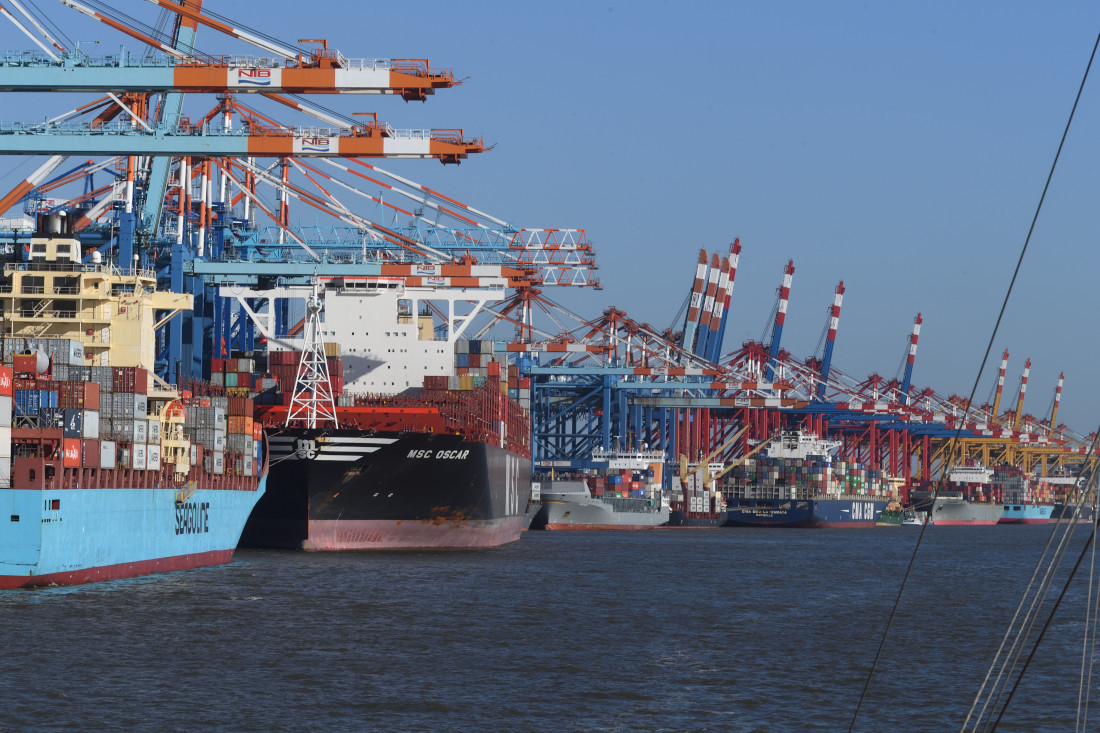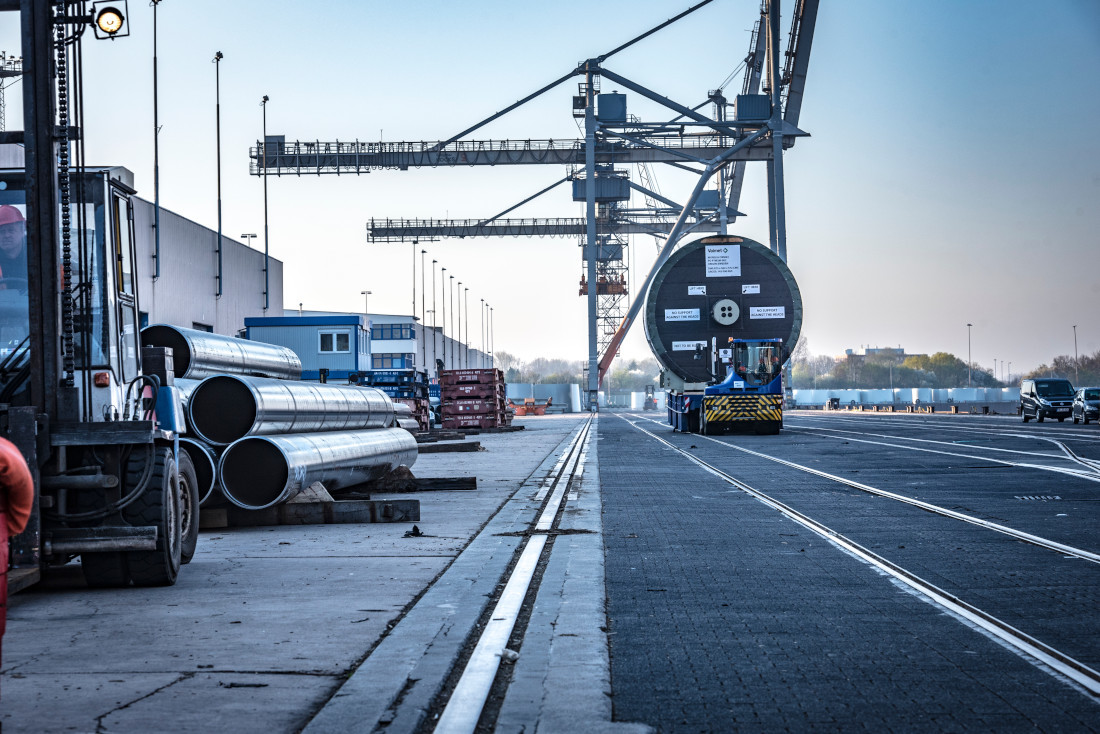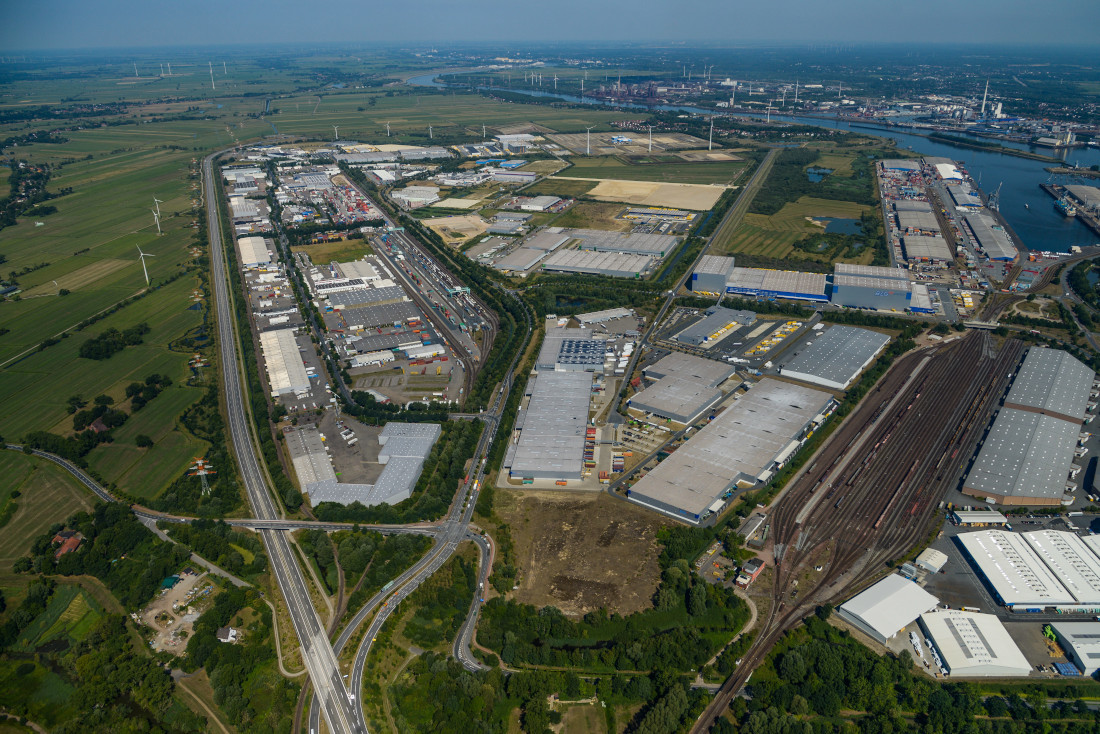Logistics hub Bremen – by land, sea and air
Maritime economy and logisticsWhy Bremen is the obvious choice for a logistics site

In logistics, there are a number of factors to consider when choosing a location. The most important are good connections to international transport routes, plenty of available premises, skilled local labour and direct links to customers. Bremen offers all of these – and quite a lot more besides.
Anyone visiting Bremen in May can experience this for themselves, during Breakbulk Europe, Europe’s largest trade fair for project and bulk cargo logistics. Not so much by watching 10,000 visitors stream into the city’s historical old quarter, but rather by getting an impression of what Germany’s largest (and Europe’s second-largest) heavy goods port has to offer. Iron, steel and forestry products are shipped to and from here, along with machinery and machine parts, wind turbines and all sorts of heavy goods, a total of four million tonnes a year. Bremen and Bremerhaven – the two cities that make up the federal state of Bremen – share the load between them. The five docks in Bremen specialise mainly in handling conventional breakbulk cargo, heavy cargo and bulk cargo. In Bremerhaven the focus is on project cargo – it is an important North Sea port for the wind energy sector.
Containers, refrigerator ships and coffee
Although the breakbulk sector is, quite literally, a heavyweight, it only accounts for a small share of Bremen’s overall logistics business in terms of absolute figures. More than 80 per cent of transshipment takes place in Bremerhaven, primarily in the processing of container ships, car carriers and refrigerator ships transporting fruit. The Bremerhaven container terminal handles around 5.5 million standard container equivalents (TEU), making it the fourth largest in Europe. It’s an impressive sight – gigantic container vessels from Asia dock at the continuous five-kilometre quay, right on the Weser estuary, which is able to accommodate ocean-going vessels. Close by, ships are being loaded and unloaded at the BLG Group’s car terminal. Bremerhaven is Europe’s leading automotive transshipment hub, importing or exporting around two million vehicles per year. Such figures are quite hard to visualise. A cup of coffee makes things a bit clearer. Bremen is Germany’s ‘coffee capital’, with half of all coffee beans entering the country being imported through the city’s ports. Breakbulk cargo, cars, containers, coffee – add it all up and it would be fair to claim that Bremen’s ports are among the most important general ports in Europe. But this high ranking hasn’t just come out of nowhere. Anyone with a keen interest in maritime logistics knows that a quay and a crane alone do not make a port. Far more important is the wide-ranging logistics expertise behind them – an effective chain of people and infrastructure that enables all types of goods to be quickly transported inland from the port, to reach customers and consumers. The journey of a container begins at the container crane, where it enters the port’s internal transportation system before continuing onwards by rail or motorway link to a distribution centre or transshipment hub.

A region dedicated to logistics
This is where Bremen comes into its own. A complementary logistics network has developed around the region’s ports that channels the flow of goods to their European destinations. A total of 1,000 logistics companies employ almost 20,000 people, making one in three local jobs dependent on the maritime or transport sector. For logistics businesses, the region is an obvious location choice, as it offers them everything they need.
Cargo Distribution Center is Germany’s top logistics hub
The various companies all perform a complex logistics ballet around the clock, with the Bremen Cargo Distribution Center (GVZ) right at the heart of it all. Since 1980, Germany’s first cargo distribution centre has consistently topped the rankings, thanks in part to its ideal location near the A281 motorway, which links to the A1 and important transport routes to Hamburg and the Ruhrgebiet region. The centre has an integrated road-rail transport terminal and is situated in close proximity to Bremen Airport, making it easily accessible for urgent air freight. So it’s hardly surprising that the approx. 500 hectare site is home to an ever-increasing number of logistics specialists. The GVZ offers a range of options for transferring cargo from the ports, including both road and rail. Among those taking advantage of what is on offer is BLG Logistics, which has located its high-bay storage here, one of the largest and most modern in Europe with over 200,000 pallet spaces.
The key to choosing a logistics location: space and transport links
These facts and figures show that good logistics requires space. Properly developed space, to be precise. Apart from the GVZ, Bremen has four other logistics centres, so everything is close at hand, no matter where you’re starting from. Each centre specialises in one particular sector. For example, the logistic centre Hansalinie at automotive industry is perfectly placed for access to the nearby Mercedes-Benz Bremen plant, the second largest MB facility in the world. The other logistics centres have good geographical links to the surrounding urban centres of Münster/Osnabrück, Hannover and Hamburg. In the city of Bremen alone there are around three million square metres of logistics space – that is about 50 per cent of the total logistics space in northern Germany. This amount of space, combined with its excellent quality, makes the state of Bremen a preferred location choice for many logistics investors from around the world. The average cost per square metre is also lower than in other large cities – another reason why vacancy rates tend to be low, as is evident from the annual Bremen real estate report.

Science and research
None of this would be possible without skilled labour. Compared to other locations, companies in Bremen benefit from a good supply of highly qualified workers, particularly when it comes to innovative technologies. The region’s eight universities and colleges produce a steady stream of smart thinkers who are keen to apply their ideas locally, for example in one of the three innovation labs. One of these, BLG Group’s Digilab, specialises in digitalising logistics. Others, like the Bremen Institute for Production and Logistics (BIBA), are working on the port and logistics technologies of the future, covering everything from autonomous port vehicles and robots that unload containers to intelligent navigation and organisation systems.
In Bremen, they know that the next step in terms of efficiency and productivity can only be achieved by systematically digitalising every individual link of the chain. In the future, data about goods is going to be just as important in international goods distribution as the goods themselves. Anyone choosing a logistics location would do well to bear the requirements of logistics 4.0 in mind.
The first ‘green’ business park
In Bremen, all the links of the chain fit neatly together. But there is another aspect which is essential for the future: the green economy. The logistics industry has to make its own contribution to reducing the effects of climate change. In addition to research projects aimed at reducing energy consumption, the Green Economy project is creating a sustainable business park in the southern part of Bremerhaven which will offer renewable energies, sustainable water management, designated social infrastructure spaces and areas close to work that are designed for recreation, sports and leisure. Bremen and Bremerhaven will continue to be dedicated to logistics– by land, sea and air.
Success Stories
10 Leading Coffee Companies from Bremen
From trading to roasting to logistics – no one does coffee quite like Bremen. But who are the players driving the business in Germany’s coffee capital? Meet ten of them.
Learn moreProfile of Bremen's eight ports
Bremen's ports are the engine that drives economic activity throughout the region. But do you know which goods arrive and depart, and where? We have taken a look around the eight port complexes in Bremen.
Learn moreThe Polymath from Horn-Lehe
No can do? No such thing! GERADTS GMBH makes the things other companies can’t even imagine. This is why this engineering firm is so firmly rooted in major European aviation and aerospace projects, and also in a myriad of other sectors.
Learn more
